Good Temperature To Keep House In Winter

Finding the sweet spot for your home's temperature during winter is a balancing act. You want to be comfortable, but you also want to keep your energy bills manageable. This article explores the various factors that influence the optimal temperature setting, considering efficiency, health, and different occupancy scenarios.
The Goldilocks Zone: Finding Your Ideal Winter Temperature
There's no one-size-fits-all answer to the "best" temperature for winter. However, experts generally recommend setting your thermostat to 68 degrees Fahrenheit (20 degrees Celsius) when you're home and awake. This provides a comfortable environment for most people without excessively straining your heating system. When you're asleep or away, lowering the temperature is key to saving energy.
The Science Behind 68 Degrees
The 68-degree recommendation stems from a combination of comfort studies and energy efficiency analyses. Studies have shown that this temperature range allows most people to feel comfortably warm while minimizing heat loss from the building. Think of it this way: the bigger the temperature difference between inside and outside, the faster heat escapes. Maintaining a moderate indoor temperature reduces this rate of heat loss.
The Overnight and Away Game: Lowering the Temperature for Savings
When you're asleep or away from home, your body's metabolism naturally slows down, and you don't require as much warmth. During these times, lowering your thermostat by 7-10 degrees Fahrenheit (4-6 degrees Celsius) can result in significant energy savings – typically around 10% on your heating bill. This is where programmable thermostats shine. They allow you to automate temperature adjustments based on your schedule, ensuring comfort when you need it and savings when you don't.
Programmable Thermostats: Your Energy-Saving Ally
A programmable thermostat is a small investment that can pay off big in the long run. These thermostats allow you to set different temperatures for different times of the day and different days of the week. For example, you can program your thermostat to lower the temperature to 60 degrees Fahrenheit (15.5 degrees Celsius) while you're at work during the day and then raise it back to 68 degrees Fahrenheit (20 degrees Celsius) an hour before you arrive home. There are several types available:
- Basic Programmable Thermostats: Offer simple scheduling features for weekdays and weekends.
- Smart Thermostats: Connect to your Wi-Fi network and allow you to control your heating system from your smartphone or tablet. They can also learn your habits and automatically adjust the temperature based on your preferences. Many smart thermostats can integrate with smart home systems like Amazon Alexa or Google Assistant.
- Learning Thermostats: Automatically learn your temperature preferences and create a schedule based on your habits. They also incorporate features like occupancy sensors to detect when you're home or away.
Consider a smart thermostat with zone control for larger homes. Zone control allows you to independently control the temperature in different areas of your house. This is especially useful if you have rooms that are rarely used or if some family members prefer different temperatures.
Health and Comfort Considerations
While saving energy is important, it's crucial to consider the health and comfort of your family. Maintaining a comfortable indoor temperature can help prevent respiratory problems and other health issues. Here are a few factors to consider:
- Infants and Elderly: Infants and elderly individuals are more sensitive to temperature changes and may require warmer temperatures. For newborns, a room temperature of 68-72 degrees Fahrenheit (20-22 degrees Celsius) is generally recommended. For elderly individuals, 70-72 degrees Fahrenheit (21-22 degrees Celsius) might be preferable.
- Health Conditions: Certain health conditions, such as arthritis or asthma, can be exacerbated by cold temperatures. Individuals with these conditions may need to maintain a higher indoor temperature.
- Humidity: Low humidity can make your home feel colder than it actually is. Consider using a humidifier to increase the humidity level in your home during the winter months. A relative humidity level of 30-50% is generally recommended.
HVAC System Efficiency and Maintenance
The efficiency of your HVAC system plays a significant role in determining your heating costs. A well-maintained system will operate more efficiently and use less energy. Regular maintenance can also extend the lifespan of your system and prevent costly repairs.
Annual Maintenance Checklist
Here's a basic maintenance checklist you can follow:
- Change or Clean Air Filters: Dirty air filters restrict airflow and reduce the efficiency of your system. Change or clean your air filters every 1-3 months, depending on the type of filter and the amount of dust in your home.
- Inspect and Clean Vents: Make sure your vents are clean and free of obstructions. Dust and debris can accumulate in your vents and reduce airflow.
- Check for Air Leaks: Seal any air leaks around windows, doors, and other openings. Air leaks can significantly increase your heating costs.
- Schedule Professional Maintenance: Have your HVAC system professionally inspected and tuned up at least once a year. A qualified technician can identify and fix potential problems before they become major issues. They will typically inspect and clean the blower motor, check the refrigerant levels (if applicable), and test the system's safety controls.
Understanding AFUE Ratings
The Annual Fuel Utilization Efficiency (AFUE) rating measures the efficiency of a furnace. It indicates the percentage of fuel that is converted into heat. For example, a furnace with an AFUE rating of 90% converts 90% of the fuel into heat, while the remaining 10% is lost. Furnaces with higher AFUE ratings are more efficient and can save you money on your heating bills. Energy Star certified furnaces have an AFUE rating of 95% or higher.
Heat Pumps vs. Furnaces: A Comparison
When choosing a heating system, you have several options, including furnaces and heat pumps. Furnaces burn fuel (natural gas, propane, or oil) to generate heat, while heat pumps transfer heat from one place to another. In winter, a heat pump extracts heat from the outside air and transfers it inside your home. In summer, it reverses the process and transfers heat from inside your home to the outside air. Heat pumps are generally more energy-efficient than furnaces, especially in mild climates.
However, heat pumps can become less efficient in extremely cold temperatures. When the outside temperature drops below freezing, the heat pump may need to use supplemental electric resistance heat to maintain a comfortable indoor temperature. This can significantly increase your energy costs. In colder climates, a dual-fuel system, which combines a heat pump with a gas furnace, may be the best option. The heat pump operates during mild weather, and the gas furnace kicks in when the temperature drops below a certain point.
Addressing Drafts and Insulation
Even with an efficient HVAC system and a well-programmed thermostat, drafts and poor insulation can sabotage your efforts to save energy. Drafts allow cold air to enter your home, making it harder to maintain a comfortable temperature. Poor insulation allows heat to escape from your home, increasing your heating costs.
Identifying and Sealing Drafts
Common sources of drafts include:
- Windows and Doors: Seal any gaps or cracks around windows and doors with weatherstripping or caulk.
- Attic Hatch: Insulate the attic hatch and seal any gaps around it.
- Electrical Outlets: Install foam gaskets behind electrical outlets and switch plates on exterior walls.
- Plumbing Penetrations: Seal any gaps around pipes that penetrate exterior walls.
Improving Insulation
Proper insulation is essential for keeping your home warm in the winter and cool in the summer. The amount of insulation you need depends on your climate and the type of construction of your home. In general, attics and walls should be insulated to the recommended R-value for your region. R-value measures the resistance of a material to heat flow. The higher the R-value, the better the insulation.
Common types of insulation include:
- Fiberglass: A common and relatively inexpensive type of insulation.
- Cellulose: Made from recycled paper products and treated with fire retardants.
- Spray Foam: Provides excellent insulation and air sealing.
- Rigid Foam Boards: Used for insulating walls, roofs, and foundations.
Conclusion: A Holistic Approach to Winter Comfort
Maintaining a comfortable and energy-efficient home during the winter requires a holistic approach. By setting your thermostat to the appropriate temperature, using a programmable thermostat, maintaining your HVAC system, addressing drafts and insulation, and considering the specific needs of your family, you can strike the right balance between comfort and cost savings. Remember, 68 degrees Fahrenheit (20 degrees Celsius) is a good starting point, but the ideal temperature may vary depending on your individual circumstances.










